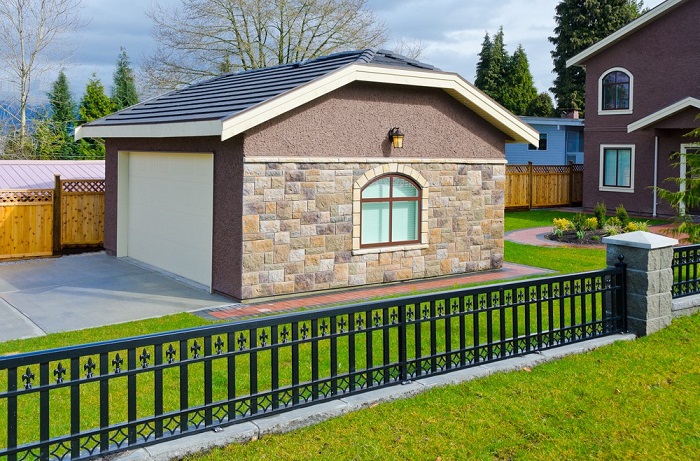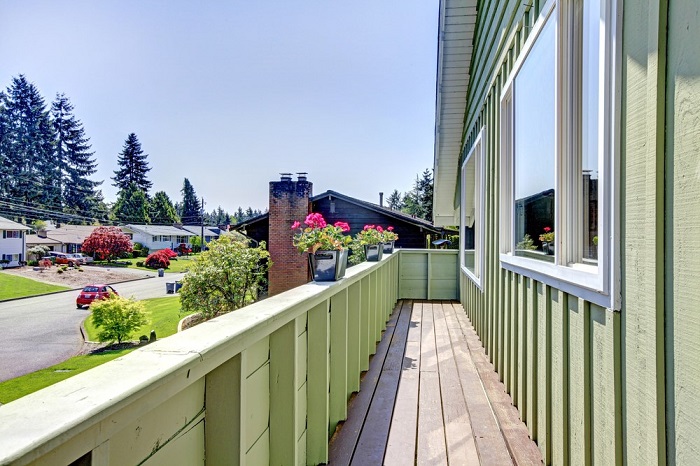Fitting a new house onto a narrow lot brings a host of unique challenges. In addition to fitting an efficient, attractive new home on the property, you have to figure out where its inhabitants —namely you — are going to park. You can park on some streets, but you leave your car exposed to potential fender-benders and weather damage. If you live in a northern climate, then your city probably has parking restrictions requiring you to remove your car for snow removal and street sweeping.
Fortunately, with a little creativity and with some well-designed narrow house plans, you can have both a garage and a narrow lot home. Your options include traditional front-facing garages, rear or side-facing attached garages, and detached garages.
Front-Facing Attached Garage
Fitting a garage within the same structure as your living space can seem daunting when you’re already building your home on a cramped, narrow lot. Fortunately, a lot of narrow house plans include front-facing, attached garages for one or two vehicles. You can park not only in the garage but also in the driveway leading to the road. If your house plan won’t accommodate a two-car garage, you’ll still protect your car from careless drivers.
Another advantage of a front-facing garage is that it frees your backyard to become an additional outdoor room. If you scoot the garage around the back to enhance curb appeal, you sacrifice valuable space for gardening or entertaining guests. If you have children or dogs, they’ll also lose valuable space that you could have fenced in for their safety.
If you choose a front-facing garage, keep these considerations in mind:
- Curb appeal. Avoid letting the garage door gobble up the entire front of your home. Fortunately, since most narrow lot homes build upward rather than outward, you’ll minimize the appearance of the garage door.
- Homeowners never intend for their garages to become storage spaces, but clutter inevitably gravitates to attached garages. To avoid attracting clutter and ending up with your car out in the elements, keep the garage small.
- If a front porch is a must-have for you, consider locating your garage elsewhere. Alternatively, if you just want to put some landscaping near your front door, the front-facing garage will be fine.
Rear or Side-Facing Attached Garage
To move the garage away from the front of a home, many architects design houses with garages facing the rear or sides of a lot. If your house backs up to an alley, a rear garage makes a lot of sense. Also, if your house plan includes a first floor with living space at the front, a garage at the rear and a full second story over both the living space and the garage, a rear or side-facing attached garage becomes a practical use of space.
The disadvantage of a rear garage is that a rear driveway swallows up a good portion of your backyard. If you need a lot of living space, tucking a side-facing garage into your first floor might not be ideal because without windows in the rear, your first-floor space might be dark. Also, a protruding side garage plus a driveway leading to it might not fit on your narrow lot. Again, the decision depends on where you like to relax and how much floor space you need.
Detached Garage
On a narrow but long lot, a detached garage makes a lot of sense. You can have sufficient backyard space and living space without sacrificing curb appeal, and you can locate your driveway in a more convenient spot. For additional storage or workspace, you could build a detached garage and add a second story.
A detached garage becomes more expensive because you have to dig out an additional foundation for the structure. If you decide to heat your garage during winter, you’ll incur additional construction expenses. You also have to walk from the garage into your home using a pathway, which is inconvenient during inclement weather. Still, if these disadvantages don’t bother you, a detached garage is a great use of space.
Review as many narrow house plans as possible to see multiple approaches to the narrow lot garage conundrum. Then, talk to your builder about which solution is right both for your lot and for the way that you live.






